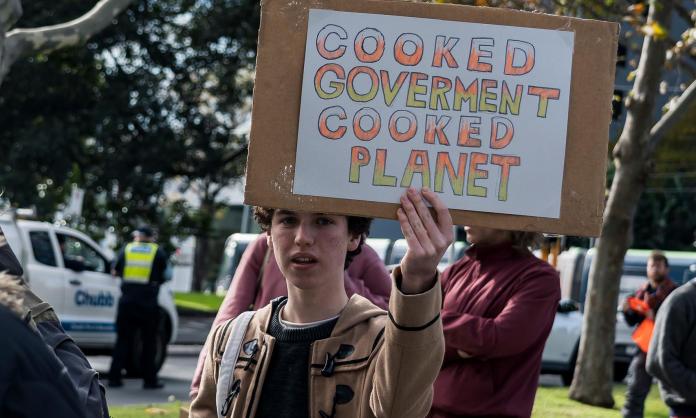It’s early summer 2024. Australia’s eastern states are in the grip of a severe drought. The preceding year, starting with the El Niño weather pattern that developed in the spring of 2023, has been one of record low rainfall and high temperatures. The land is parched, and bushfires are threatening towns and cities all along the eastern seaboard.
In Sydney, it seems the catastrophe of 2019 is repeating. The city is ringed by out-of-control fires. The air has been thick with smoke for weeks. Residents bunker down at home with the windows closed. On the urban fringes the sky glows red. People keep a close eye on the wind, knowing that at any moment the wall of flames could approach.
The largely volunteer firefighting force is stretched to breaking point. Several firefighters have died. Others have been hospitalised with exhaustion. And with temperatures only just heading into the hottest months of summer, there’s no end in sight.
Inside the climate-controlled environs of a major city conference centre, however, a very different scene is unfolding. Over the past week, delegates have flown in from around the world to attend the inaugural Global Nature Positive Summit. The conference was announced by the federal and New South Wales Labor governments in August 2023, and has been heavily promoted as an opportunity to talk about business opportunities in the area of “nature repair”.
In the foyer of the conference centre, and the dining rooms and bars of the luxury hotels surrounding it, government ministers from countries around the world rub shoulders with fossil fuel company executives, bankers, hedge fund managers, leaders of major environmental NGOs and a smattering of select representatives of Indigenous groups and community organisations.
The first session is opened by Jakob Stausholm, CEO of mining giant Rio Tinto. “It’s good to see so many of my colleagues in the mining and fossil fuel industries here today”, he says. “We, more than anyone, know the value of remaining nature positive, even when so many people around us are stuck in a nature negative mindset.
“And I’m very happy, as the government’s—sorry [cough], the conference’s—main sponsor, to introduce our first speaker for today. Please welcome to the stage my good friend, Australia’s Environment Minister Tanya Plibersek”. The crowd of more than 2,000 rise to their feet for an extended standing ovation.
“Thank you, Jakob, and thank you to your wonderful New South Wales Premier Chris Minns. I’d like to start by ...” Suddenly, there’s a commotion at the back of the room. A handful of protesters, it seems, have managed to get through the conference’s many layers of security and are making their way down the aisles towards the stage, chanting: “No more lies! Climate action now!”
A security guard rushes from the side of the stage and stands between the protesters and Plibersek, but the minister seems unperturbed. “This is a democracy”, she says. “You have the right to your opinion.” The protesters mount the stage and unfurl a banner which reads: “Stop greenwashing the climate emergency”.
“You have the right to your opinion”, Plibersek continues, “but you don’t have the right to infringe the freedom of others. You’ve had your say, now please let me continue”. The crowd murmurs—some cheer, some boo, others look around uncomfortably. The protesters appear determined to stay. By this point a small contingent of police has entered the auditorium and made its way to the stage. At a nod from Plibersek, cops rush up the steps and tackle each of the protesters to the ground. They are handcuffed and dragged away into the backstage area.
“I trust your boys will deal with them appropriately Chris”, Plibersek says, searching out the NSW premier among the faces in the front row. The premier laughs and gives a thumbs up. The state’s harsh anti-protest laws—passed in 2022 in response to disruptive actions by climate activists—have become a model for governments around the world. Many in the crowd are laughing too. They’re in on the joke.
“Now, where was I? OK, I’d like to start by acknowledging the traditional owners of the land on which we’re meeting today, the Gadigal people of the Eora Nation, and paying my respects to elders past, present and emerging. It’s important, I think, to make this acknowledgement of a people who have been custodians of this land for tens of thousands of years.
“Without all the hard work of custodianship they did, we wouldn’t be blessed with the land of Australia that we know and love today—a land of immense natural beauty, but also of immense natural wealth. Without their custodianship, we wouldn’t have the opportunity, today, to fully unlock this land’s potential, which has been valued by some economists at up to 500 trillion dollars.
“What does it mean to be ‘nature positive’? It can be hard at times like this to keep that mindset. Whenever we go outside—not that I want to encourage that [laughter]—we’re reminded of some of the challenges we face. Whether it’s bushfires, droughts and heatwaves like we’ve seen here in the past year, or any of the other major climate-related disasters people are suffering around the world today, it can be difficult to see the silver lining.
“What the Nature Positive Summit is about, though, is looking at all this from a different angle. It’s about seeing the opportunity in adversity. It means looking beyond the superficial things that preoccupy those of a nature negative mindset—the death and destruction, the accelerating ecosystem collapse, mass extinctions, all that doom and gloom—and focusing on the positives: the growing business opportunities that exist in nature repair and, increasingly, also in the field of human society repair too.
“Yes, we want to keep digging up and shipping out that coal and gas—with 116 new projects in the pipeline, that’s exactly what my government is doing. But there’s also a lot of money to be made from carbon capture and storage and other offsetting schemes. There are opportunities in reforestation, or at least schemes that can be made to look like reforestation in a balance sheet. And under our plan to create a ‘green Wall Street’ and sell off rights to other parts of nature, you’ll soon be able to do the same thing with koala habitats, rivers, coral reefs and many other things too.
“The possibilities are endless. And I haven’t even started on the human side of it. As I speak to you today, homes on the outskirts of this great city are threatened by fire. In the coming weeks, many of these homes, and unfortunately some lives, are likely to be lost. This is a tragedy. But with the kind of entrepreneurial spirit that I know is alive and well among the global thought leaders assembled in this room today, this too, can be turned into an opportunity.”
As the minister continues her speech, she can feel that she has hit the mark. The audience is carried away entirely by the bold and imaginative picture she paints of a nature positive future full of new, potentially highly lucrative, opportunities for savvy investors, green capitalists and well-governed and collaborative NGOs. She believes in this future, and wants others to believe in it too. As she concludes her remarks and waits for the first question from the audience, she smiles, thinking about the positive write-up she’s likely to get in tomorrow’s Financial Review.
Outside the conference centre, the wind, and the temperature, are rising. What had been a milky-white haze of smoke has darkened into a thick and ominous pall. The handful of climate protesters sit quietly, drenched in sweat, in the back of a sweltering divvy van—still waiting to be taken to the lockup. In the western suburbs, sirens blare.
PHOTO CREDIT: Matt Hrkac (Flickr)









